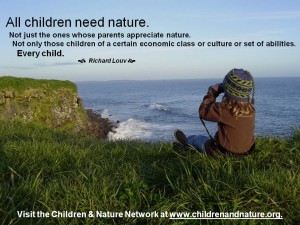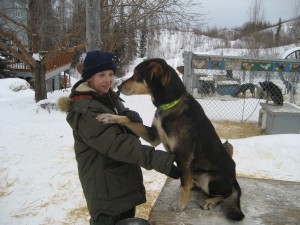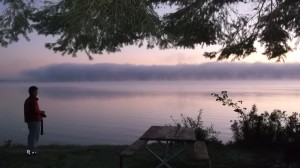IditaNature! Get Outside!
 Carmen Field, with the Kachemak Bay National Estuarine Research Reserve and Kids in Nature launched an exciting new initiative for connecting children with nature during the 2010 Iditarod Sled Dog Race. In the past several years, more than 300 Alaskan kids (preschoolers and elementary students) from schools in Homer and Anchorage, Alaska met the challenge of spending at least the same amount of minutes outdoors as the mileage of the Iditarod Great Sled Race (1,150 minutes/miles).
Carmen Field, with the Kachemak Bay National Estuarine Research Reserve and Kids in Nature launched an exciting new initiative for connecting children with nature during the 2010 Iditarod Sled Dog Race. In the past several years, more than 300 Alaskan kids (preschoolers and elementary students) from schools in Homer and Anchorage, Alaska met the challenge of spending at least the same amount of minutes outdoors as the mileage of the Iditarod Great Sled Race (1,150 minutes/miles).
What is IditaNature and how do kids participate?
IditaNature is a fun way to encourage outdoor play while learning about the amazing Iditarod Trail Sled Dog Race. During Feb./March each year, children are each challenged to play outside for 1,150 minutes, while the Iditarod Trail Sled Dog Race is underway.
As a teacher, you know the benefits for students – when they have opportunities to get outside and stay active they are more engaged in the classroom! Create a program in your school and community to promote healthy living and get your students more active this year! Activities can include anything that gets students out of the building and into the outdoors: Iditarod education activities, taking walks or hikes, looking at nature, playing games, winter sports, looking at the clouds, or anything at all! Outdoor activities can be planned through a school’s or school district’s PE program, by increasing recess time or outdoor class time – with administrative support – during the weeks of the race, by building outdoor time into curriculum / lesson plans, or with the help of parents (to add time outdoors beyond the day at school). Kids will be healthier, happier, and smarter having spent more time outdoors!
 “No child can truly know or value the outdoors if the natural world remains under glass, seen only through lenses, screens, or computer monitors.” – Richard Louv
“No child can truly know or value the outdoors if the natural world remains under glass, seen only through lenses, screens, or computer monitors.” – Richard Louv
Sample Race Project Calendar and Optional Observation Log Note: Use this calendar and log any race year. The Observation Log is optional. Remember, the objective behind this project is to get outside. Any writing with this project must be minimal and not extensive to help students gain an appreciation of ‘outside’ and gain maximum benefit from being out of doors. This is a time to play outside. A time to hike, to relax, to enjoy being outside instead of within the walls of the classroom! We suggest if you are going to use the log, that it be student choice or extra credit ONLY. AND as an additional challenge to teachers, take your class outside to read, to write, to walk, or to just relax on a regular basis! Help students develop a healthier life style and a richer appreciation for our environment.
Now, what are you waiting for? Get outside!
Idita-Nature! Get Outside: Academic Purpose of the Project
Kids Need Nature: Idita Nature by Carmen Field
 Many adults have a deep-rooted connection to the outdoors. If we were collectively asked how that connection was created, most of us would undoubtedly reflect back to our childhoods. We fished, hunted, farmed, explored, and swam. Some of us may have been blessed with a special adult – teacher, relative, or neighbor – who nurtured an interest in the environment. Others of us may have simply been encouraged by parents to play outside. But regardless of how that bond with nature was forged, we’ve grown into adults who care about our natural resources and wild places.
Many adults have a deep-rooted connection to the outdoors. If we were collectively asked how that connection was created, most of us would undoubtedly reflect back to our childhoods. We fished, hunted, farmed, explored, and swam. Some of us may have been blessed with a special adult – teacher, relative, or neighbor – who nurtured an interest in the environment. Others of us may have simply been encouraged by parents to play outside. But regardless of how that bond with nature was forged, we’ve grown into adults who care about our natural resources and wild places.
Our children’s generation, as a whole, is not developing this same relationship with nature. In the words of author Richard Louv, who wrote the catalyzing Last Child in the Woods: Saving Our Children from Nature-Deficit Disorder, today’s young people are engaged in a remarkable retreat to the indoors. Over the past 40 years children have become less and less connected to the outdoors, with more kids likely to experience nature through the lens of TV than through a magnifying lens or up close and personal while playing in the fresh air. For a plethora of reasons – including liability issues, safety from strangers and dangerous wildlife, over-full schedules (of both parents and kids), changing landscapes, and the draw of “cool” technologies – today’s kids are not spending much time outside.
This lack of contact with the outdoors is not good for children. With this affliction comes the loss of so many benefits from nature, among them opportunities for improving creativity, self esteem, cooperation, ability to focus, coordination, and courage; warding off childhood obesity; reducing some of the effects of Attention Deficit Hyperactivity Disorder (ADHD); and the creation of our planet’s stewards, who by connecting with the natural world and its myriad relationships as youngsters, forge a lifelong appreciation and respect for the outdoors.
So what can be done to reverse, or at least slow, this process? Nationally, individuals and groups of people are mounting political, programmatical, and family-oriented efforts to facilitate getting children outdoors. Agencies like the US Fish & Wildlife Service, National Park Service, and US Forest Service all have programs to get kids outside; environmental non-profit organizations, too, like the National Wildlife Federation and The Nature Conservancy are supporting the movement to reconnect children with nature. And businesses like REI and North Face are working to provide opportunities for our country’s youth to get outdoors. Multi-organizational efforts such as the No Child Left Inside Coalition (which supports the bipartisan 2009 No Child Left Inside legislation introduced in both the House and Senate with wide sponsorship from Congresspeople) and the Children & Nature Network (www.childrenandnature.org) are perhaps the best examples of collaborative progress made in the movement at the national level to reconnect young people with the outdoors.
Across the country there are now over 80 community campaigns to reconnect children with nature, with 83 family nature clubs formed in just the past two years. There is a Natural Leaders Network of youth and young adults getting kids outside and participating in outdoor service projects. There is a Natural Teachers Network of educators who creatively engage their students with the natural world by extending their classrooms outdoors. And the Natural Families Network provides all sorts of tools and resources to help parents, grandparents, and caregivers explore nature with their children. Find out more about these campaigns and networks at http://www.childrenandnature.org/movement/campaigns/.
Children are happier, healthier, and smarter when they have frequent and varied opportunities for free and unstructured play in the outdoors. In a social landscape where the game of tag is being outlawed, running is being banned at recess, and lawsuits for children’s accidents on private property are commonplace, how can parents or teachers foster a love of the outdoors? Adults who spend time with kids should get outside with their favorite little ones every day. Explore local trails, beaches, parks, forests, and gardens to experience the wonder of our natural world. Take that first step outside with a youngster, ponder the possibilities of what can be learned from nature, and don’t come in until cold or darkness overcomes you…on the other hand, maybe you’ll want to stay outdoors to experience the darkness. You, the youngsters with you, and our planet will benefit from these daily visits.
Carmen Field is the current chairperson of the Nature Rocks Homer community coalition and a science educator, naturalist, and biologist with the Kachemak Bay National Estuarine Research Reserve in Homer, Alaska.
* This article was reprinted with permission from Carmen Fields. In addition, Carmen tells us:
The Children & Nature Network’s Grassroots Gathering in New Jersey this month was amazing, as it is every year thanks to its energetic, motivated, and inspiring group of leaders who participate from across the country. My colleagues who attended are very excited about bringing IditaNature to their communities, schools, and families. Thank you so very much for posting information on IditaNature on your website! It looks great!! Hopefully families and teachers visiting the website will find it and be inspired to participate in the challenge next March.
Carmen
Learn more about Science Education at the Kachemak Bay Research Reserve at this link.


